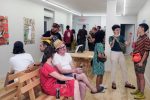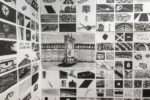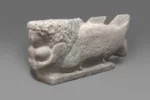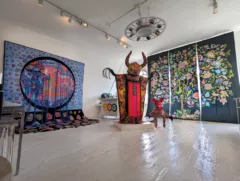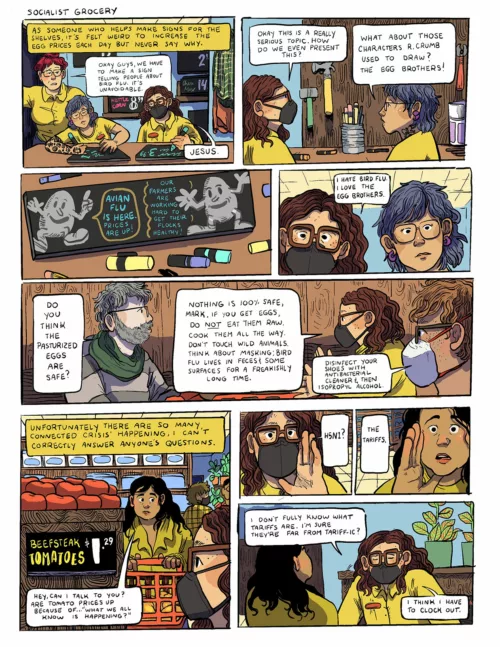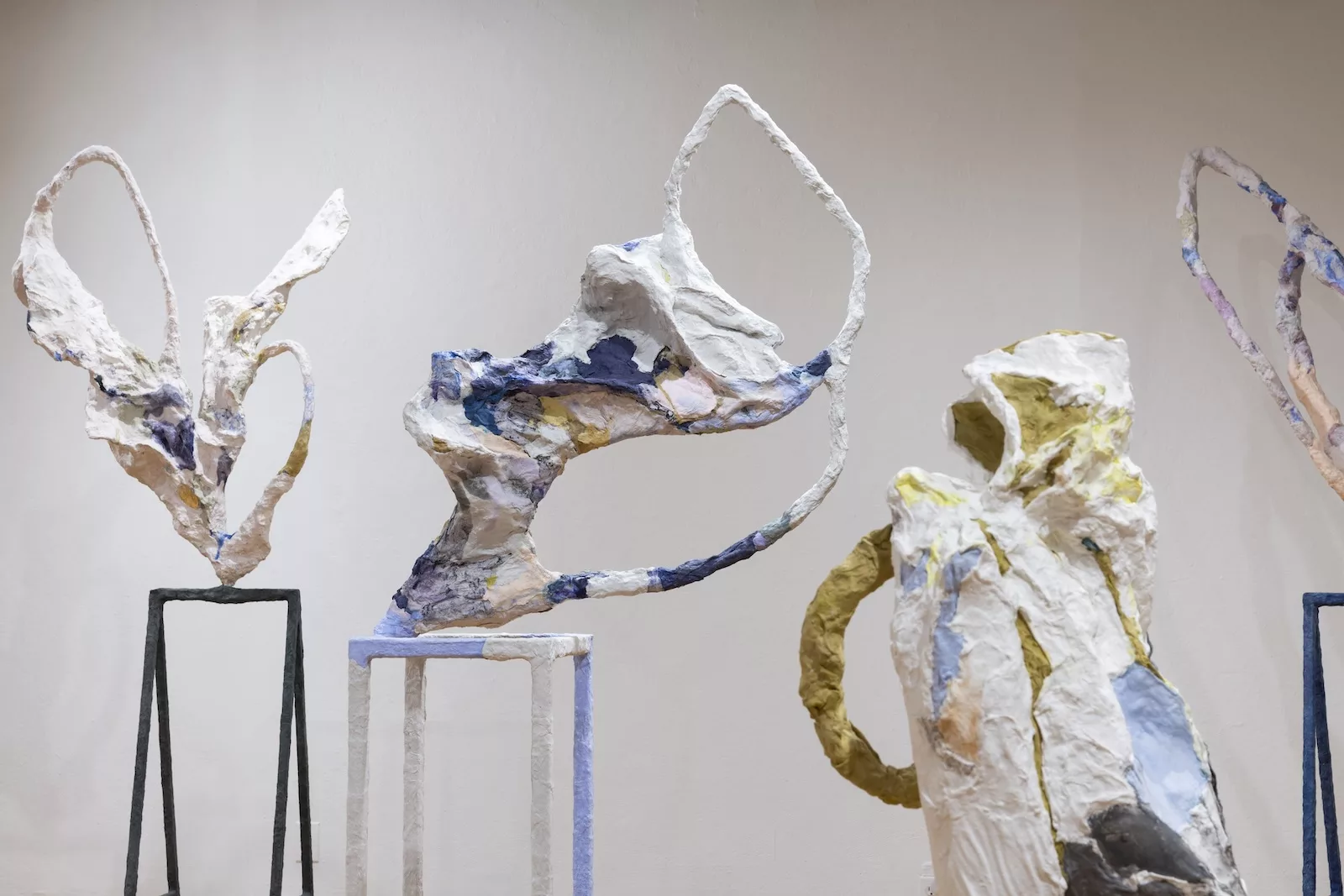
Susan Isaacs interviews Alexis Granwell, whose solo exhibition is part of the Wind Challenge series at the Fleisher Art Memorial during the month of July. As a curator, Isaacs has been following Granwell’s career since c. 2011, and in the past, has shown her work at the Delaware Contemporary and at Towson University. Here, she discusses the artist’s practice, methods, materials, and the ideas that inform her current sculptures. This interview was conducted in person in the gallery, on Zoom, and via email.
Susan Isaacs: First, can you talk a little bit about how you were offered this exhibition opportunity?
Alexis Granwell: This exhibition is part of the Wind Challenge Competition at Fleisher Art Memorial, established in 1978 as a way to highlight emerging and mid-career Philadelphia artists. This year’s jurors are James Britt and Kathleen Eastwood-Riaño.
The structure of this competition is an open call. Artists submit digitally. If selected for the second round, artists bring work to Fleisher to be juried in person. Following the final selection, nine artists are awarded solo shows and receive stipends to support the exhibition. The other two artists showing alongside me are Brynn Hurlstone and Idalia Vasquez-Achury. We will have an artists’ exchange to discuss our practices on Friday, July 12th 5-6 PM. Following the talk, we will have a reception 6-8 PM.
I would encourage everyone to submit work to the competition! I had applied years ago; then I took a break from applying. And then, for whatever reason I decided to submit work last year, and I was really excited to receive news of the show, because, you know, it’s competitive and a longstanding tradition in Philly. Fleisher Art Memorial has such a beautiful history of making art accessible to everyone. It’s a unique place to hold an exhibition.
A New Body of Work
Susan: Did you decide to make a new body of work for the show?
Alexis: Yes, I found out I received the Fleisher show last summer, when I was preparing for my two-person show with Eleanna Anagnos Shift, Breathe. Expand: Painting in Space at SUNY, Old Westbury. SUNY’s gallery is an enormous space, over 2,000 square feet. I started making large-scale sculptures to respond to the architecture of the space. I was excited about the breakthroughs in the new work, and I wanted to continue exploring these six-foot/seven-foot sculptures. And it just continued in that vein. So, some of the pieces for the Fleisher exhibition are from 2024, and some date back to 2023, and there are a few earlier pieces from 2019. I even made one work three weeks ago that felt really pertinent, so I decided to include it. I’ve also included a few drawings that show some of the alphabet of my forms.
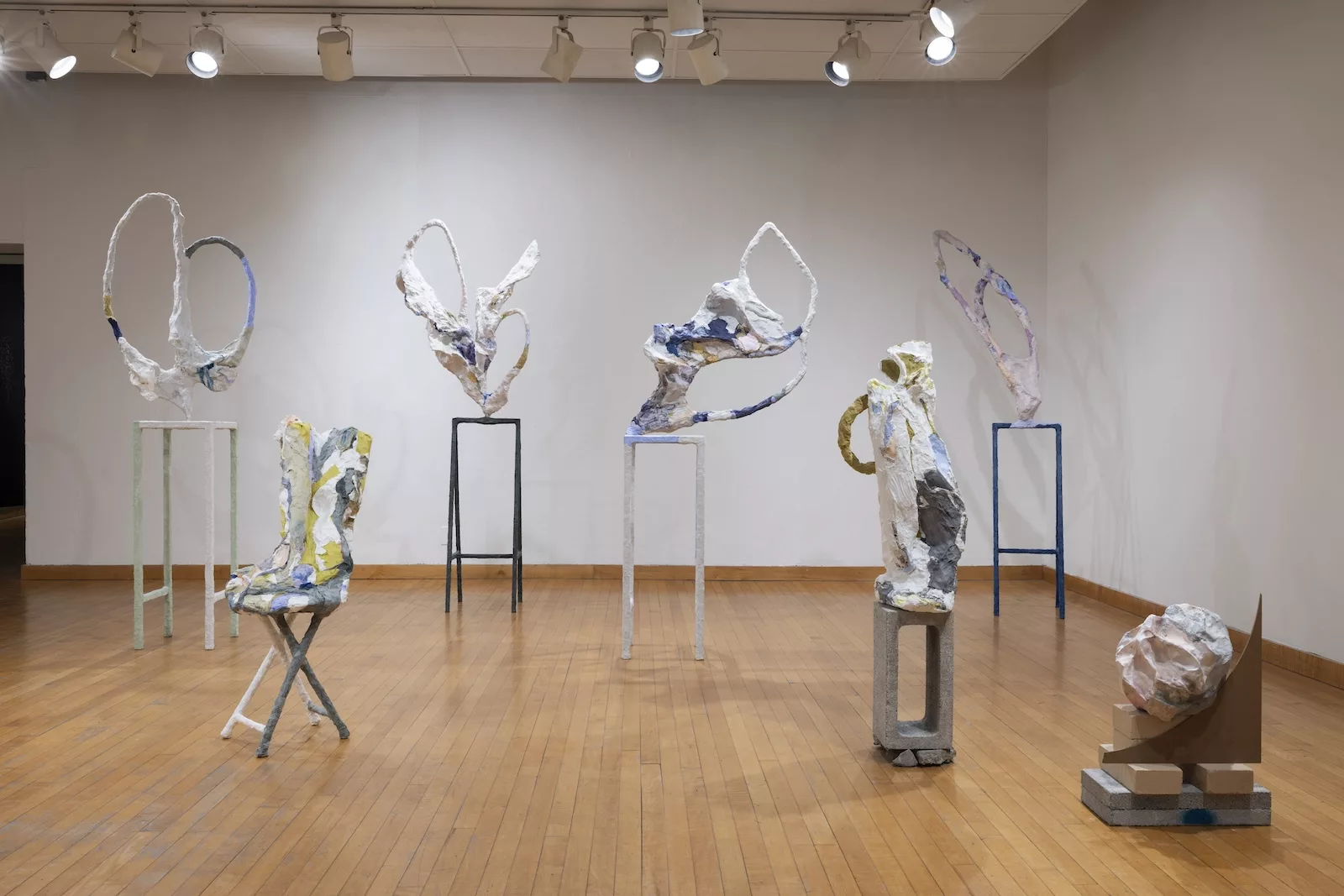
The newest piece I’ve made is in response to a recent experience in April where I was attacked by a pit bull in my neighborhood. I have several puncture wounds on my leg. Thankfully, I’ve been healing well. I made a big wall work that’s about my wound, but it also looks like the surface of the moon. This work is about fear and release, and it’s called “Animals Shaking.” I was thinking about how animals continue to shake long after a trauma occurs as their body processes the attack. I’m trying to embrace this because healing emotionally and physically can take a long time and the time it takes is the time it takes. In the Wind Challenge exhibition text written by the Philadelphia writer Leigh Gallagher, she ended up writing about the moon, which was interesting, because I don’t know if I told her about this new piece, but I feel like cycles of the moon and nature cycles are featured throughout the show. I decided to title the show: Weather Watching, because these works are about how we navigate a complicated, painful, and beautiful world as we survive it within a body. And surprisingly, the attack in April seemed to pull the themes for the show together — the observations of our world and the observations of our internal “weather systems.”
Here is the beginning of Leigh’s exhibition text, “Irrealis”:
If it were a mood—or a moon, but differently clothed, then stripped. If skin were less clingy, peelable as an orange. What new-old-scary nakedness? If it were any moon, any idea of a moon.
The rest can be found here.
Studying Art in school
Susan: What were your degrees in? Did you study sculpture, or was it painting or printmaking because now you seem to be both a painter and a sculptor?
Alexis: I studied painting at Boston University, but had an amazing sculpture professor, Ed Smith, who left after a year to teach at Bard College and Marist College. Unfortunately, I did not connect with the other sculpture faculty at BU, so I decided to continue with painting as my major. I felt sort of sad about it. This was the early 2000s. Things weren’t as interdisciplinary then, and it was very conservative in my program even though many of my professors had been students of the late Phillip Guston. But, I’ve always been interested in making a hybrid. I remember now that in high school I made a bunch of paintings on shower curtains that would shift as they were hung. I think I was very inspired by the Sam Gilliam show that I’d seen at the Hirshhorn.
Susan: I went to BU my first two years of undergrad, long before you were there. I know what you are talking about. Very siloed then.
Alexis: Yes, very siloed. I think it’s a really strong program now with amazing professors like Dana Clancy, Josephine Halvorson, and Lucy Kim. I had studied painting seriously in high school, so I thought, well, I should do this because this is what I’ve been doing. But I had these question marks about sculpture, and then I graduated, and I was very frustrated about my painting practice. My first job out of college was teaching at an art day program for disabled adults, and that totally just shifted my whole perspective about art making, because their work was so raw and so direct and visceral. And it wasn’t about mastering a craft. And I was obsessed with the work there. I got really into the power of drawing. I wanted to draw and be really direct on the page.
When I went to the University of Pennsylvania for my MFA, my drawing turned into printmaking, and printmaking is very sculptural, and that eventually led me to sculpture. And now I’m making sculptures that are paintings. It’s like this full circle.
The process of working with paper in sculpture
Susan: One of the things that I want to talk about is process. You work with paper pulp, and we talked about that before in your studio. Did you find another source for your paper pulp, because when I talked to you then, the person making it for you was moving.
Alexis: So actually, it’s so wonderful! Two of my former students at PAFA, Clay Tenhula and Abbey Lakey are now running PaperThinkTank which is founded and owned by the brilliant paper maker, Nicole Donnelly. Nicole, who formerly taught at PAFA and collaborated on paper projects for The Brodsky Center, is now in Cleveland and she is the Executive Director at the Morgan Conservatory. She has been determined to continue PaperThinkTank as an accessible paper studio in Philadelphia. Clay and Abbey have been incredible to work with this year, assisting with the pulling of sheets of paper or beating the pulp for me.
When I’m in production mode, I need a lot of paper that is already prepared in sheet form that I can laminate over the sculptures. When I received the Denbo Fellowship at Pyramid Atlantic, I spent two weeks making 100 large sheets of paper, and then I used that for six months. It’s nice to have a stock. However, owning my own equipment will offer a lot more flexibility in the studio. At some point, I’m hoping to buy my own paper beater and I’ve found an affordable one that is collapsible called the “Critter Beater.” They are built to order and hail all the way from New Zealand.
Susan: So, if it’s in sheet form, do you wet it again to make it part of the sculpture?
Alexis: Once the sheets are formed and pressed, the paper is kept wet continuously. I have stacks of wrapped wet paper layered in different colors and I store them on shelves with wheels because wet paper can be quite heavy. At this point, I have several different colors, and I’m getting more meticulous about building a color sample library. Essentially, this paper is collaged over my sculpture, forming a painted skin.
Susan: I always assumed that you put the color on after you made the sculpture, that you painted it on, but you don’t. You make colored paper.
Alexis: Pigment is embedded in the base sheets. You can see the base sheets in the bigger swaths of color in my sculptures. Then, some of the color is linen pulp paint which I’ll apply once the base sheets are made, or after it’s adhered to the sculpture. The more opaque color is made with cotton fiber and the more translucent color is made with linen fiber. I use water-dispersible pigment from Guerra to pigment my base sheets and pulp paint. These pigments are archival and lightfast and I’ve found that I can make some very saturated colors. I’m also interested in more subtle colors where I’ve pigmented using powders that are earth pigments. Pigmenting is an interesting practice, because the color changes from wet to dry. So, you need to create all these tests to discover how the true color sets, which I find really fascinating. The weight of the color changes the way the color sits in the mixture too. I love looking at how the pigments mix in the water depending on their weight.
For the cotton, I create a lot of samples with a heat gun. For the linen, the color you mix is the color it dries at, and that’s the more translucent marks you’ll see on my sculpture. It’s a lot of trial and error. And you figure something out, you try to replicate it, and it’s different because temperature or dryness of paper can change things.
Susan: Like making bread.
Alexis: Yes, exactly. I think that’s something I love about it, because I’m very intuitive when I work. Something surprising will happen and I think, ‘Oh, this is happening right now. Okay, I’m going to go with it.’
Susan: So, there’s actually three layers of color in most of your sculptures, one that’s inherent to the initial paper, and then two other ways that you color.
Alexis: Exactly. I’ve also been adding linen pulp paint to the surface when the sculpture is dry. It gives more of an opaque or crackly texture. It’s endlessly fascinating how you can play with the dimensions of the layers.
The pedestals or stands
Susan: This brings me to the relationship of your sculptures to your sculpture stands.
The historical precedent, of course, is Brancusi. Your sculpture stands are a part of the work.
Brancusi is the first person who I know of who made sculpture stands that were really a part of the work in the modern period. Yours are very different from his, but I see a modernist heritage to your desire to make a unified object where the sculpture stand is equally a part of the work.
Alexis: Yes, I agree.
Susan: And to me that is very modernist vocabulary because postmodernism tends not to be concerned with unity. This is a very generalized description of course. But the other thing about your sculpture stands that intrigues me is that they’re never the same materials; sometimes they’re cement blocks. Sometimes they’re plywood. Sometimes they’re raw wood. And yet they make a whole. Do you ever reuse them or interchange them with different works from those they were designed for?
Alexis: Initially, I thought I might mix them up but then they became so married together I couldn’t do that. I have so many pedestals at this point though that I am interested in the idea, I just haven’t done it yet. Sometimes, it’s hard to reconfigure a sculpture and I want to make something else.
Susan: And the materials?
Alexis: Sometimes it’s the way things are lying around in my studio. There’s a brick distributor on my street, so I bought a bunch of really cool cement blocks, and I like playing around with how the shapes are talking to each other. Or sometimes seeing how something is naturally stacked on something else in my studio gives me inspiration for the newer work.
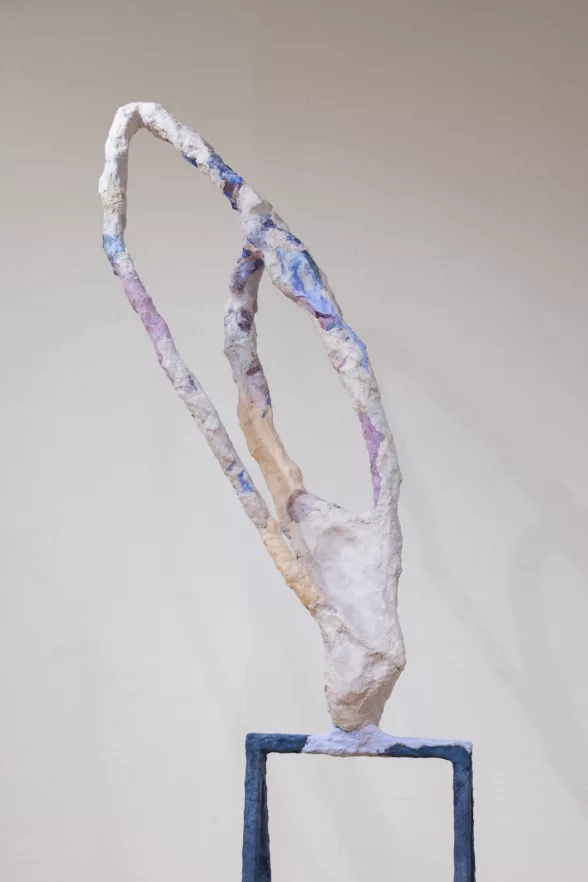
Susan: What about the new work?
Alexis: There is still a separation between the pedestal and the more organic form, but it’s all covered in paper pulp now, and that happened because I had some sawhorses and stools and metal furniture in my studio. And I thought, “Oh, that’d be really interesting underneath the more complex form. Now, how do I connect these?” And then, I learned how to weld in 2022. But with the earlier work I think I wanted to have a dialogue between shapes and openings and voids but have them contrasting in material. Conceptually, I was also thinking about time passing and layers stacked like ruins, shifting the forms as time shifts. So, the initial idea, I guess, was how something is built on top of something else and how the old always exists within the new.
Susan: Having now seen the show at the Fleisher, it does appear that the newer work is a departure from the earlier in the way you made the stands. However, the organic paper pulp form is possibly even more married to the sculpture stand in that it too is now covered with pulp. I think it makes the sculptures even more dynamic.
Alexis: Thank you. I think the way I’m separating them [the base stand and the organic form] now is with color and movement. The bottom part of the stand — which still reads as a pedestal or piece of furniture — is more solid and rectilinear, and then the top is more complex or even baroque, exaggerating weight and gravity. Some of the forms feel quite precarious due to the contrast, which I love.
I have become very excited about movement and dance in relation to sculpture. My partner, Jesse Kudler, creates experimental improvisational music and often collaborates with dancer Christine Gesualdi. They have performed within my installations twice and it is really thrilling to see live movement and sound with my sculptures. I am also interested in somatics, and I practice yoga every day. Movement informs the work I make from the initial gesture of my armatures to the way I apply color with a brush or with my hands. A lot of my earlier work was inspired by these body visualizations I was experimenting with as a healing exercise. I am fascinated by how our internal experience of something that we can’t see has a possibility to be clearly articulated into a shape that we can experience or embody within a sculpture. Sculpture is a learning tool in many ways.
Additionally, welding has opened up the movement in my sculptures. The forms can connect at precarious points because they can be welded together, and I can play with visual tension of weight in more dramatic ways. Many of these shapes feel like they’re taking flight or gently floating, which goes back to the title of the show.
Susan: What is the structure underneath the paper pulp?
Alexis: In the past, I was using craft mesh — a very fine mesh — and I would crumple it pretty intuitively into shape. Then I incorporate papier mâché, cover it with molding paste to make it water protective, and then I use the wet sheets of paper laminated around the form.
Susan: There’s not a metal or wood structure/ armature in there? The metal structure is a mesh?
Alexis: The new large-scale works have a welded metal armature throughout. Then, I use aluminum foil, which is kind of amazing because it’s extremely cheap compared to the mesh, and it feels so direct, like making a foil swan! You can twist it really quickly. Once I have the armature, it’s so fun to build something out and because it’s lightweight, I can play with scale in limitless ways.
Susan: And it doesn’t crush under the weight of the layers that happen after on top of it?
Alexis: Handmade paper is incredibly strong. Once you’ve laminated around the foil, it shrinks to the shape. And paper is incredibly sturdy. It’s kind of surprising. I didn’t think it was going to work. There was a lot of trial and error in the first sculptures. They broke a bunch of times because I was making them too heavy and too built out, and then the metal armature couldn’t handle the weight. One of my favorite pieces in the show, Embers, featured on the postcard, broke several times. I worked on that sculpture for several months as it dramatically changed shape. I learned so much in making that piece, and I think the struggle is ultimately what created such an exciting form.
Themes and concepts in the work
Susan: As a visual artist too, I am interested in the connection between process and concept. How do you come up with thematic ideas for a body of work? What’s your process for that?
Alexis: More broadly speaking, within the process of my work, there’s a sense of mending and repair in the work; the sculptures are bodily, psychological, but also like rock forms or small landscapes. Color and texture suggest processes happening to them or within them.
I’ll often make a mind map with poetic phrases that lead me to ideas for forms or even color palettes. It’s a way to express and explore all the possibilities of these forms that I’m making.
Susan: Oh, a bubble diagram!
Alexis: Exactly. I think this stems from my recent exploration with poetry. Since the pandemic I have been writing as a parallel practice.
Susan: Did you take a poetry class to get started?
Alexis: I’ve taken many classes with Holly Wren Spaulding, who runs a group called Poetry Forge. She offers many different classes, from writing to editing, and each class holds a different theme. She shares a lot of contemporary poetry. However, I am really fascinated by the Ancient poetry she has shared like the poet Li Po. Some of his poems feel like they could have been written today, and it’s wonderful to feel connected to the past through this basic human experience of meditating on something like the qualities of a season.
The first class I took was about Zuihitsu poetry. Zuihitsu translates as “running brush,” and this form is built out of fragmented ideas that can explore something ineffable. I felt that this was such an expansive way for me to experiment with language and parallel the fragmentation of collage within my sculptures. I also love Holly’s classes because she invites all poets and “secret poets.” I’m definitely a “secret poet,” although I did make a small book of poetry last year called Half Knot.
I’m curious about how language can inform abstraction. Using language is very intriguing to me, because my work stems from ideas of embodiment, materiality, and touch. Through this practice, the content emerges. So then, to be able to write, it brings me to a different kind of specificity. The poetry has led me to a lot of different themes about time and life cycles as well as narrative. Many of my poems ended up being about the weather. It makes sense because I’m fascinated by observing qualities of light to describe internal experience. I mostly studied landscape painting when I was in undergrad, and this interest has been a thread in my work since I began making art.
I’m also fascinated by the smaller artifacts in the natural world, like stains on the ground or moss. The work I’ve been making since the pandemic has been very much about watching something closely, but from afar.
The human figure, elegance, awkwardness and touch
Susan: I also see the relationship to the human figure in your work, because when you make a
stand and then you put an organic form on it, it becomes a column. If you think of Antiquity, and you think of the structure of columns— the base, shaft, and capitol— they were compared to the human body, which in ancient Greece was absolutely understood. And you have the more feminine as you move to the Ionic, and then to Corinthian. But I also see the idea of such ancient works as the Nike Samothrace, especially when you rest a form on a point as if it is ready to fly. And you use a lot of white, which is how we know Greek sculpture in modern times. We have not talked about the possible impact of Greek sculpture on your work before.
Alexis: That’s so interesting, because I’m much more inspired by non-western sculpture. However, I’ve actually been to Athens. I was lucky enough to visit the Acropolis last year, and the complexity of the columns is unreal.
I printed out a bunch of photos from my trip, particularly the more fragmented sculptures from the Anthropology Museum. While I was working on Embers, I picked up a photo, and there was this moment of synchronicity because I’d made a similar shape. It was like one of those moments where it was in my head, but I wasn’t looking at the picture. And so, I think that trip to Athens was really informative in terms of form, fragmentation, and architecture.
Susan: I also see a contrast between elegance and awkwardness in your work. I imagine the elegance and destruction of the ruins would also appeal to you.
Alexis: I think the Cycladic period in Greek art is the most appealing to me. There is a refined crudeness with an intense emotional quality to these complex but simple forms. I also love the intimacy of the small-scale sculptures. There is a whole world in there. We actually have a little replica in our house from a gift shop. It’s very cool.
Susan: Going back to the connection between the column, the human figure, and architecture and how they hold up the building. And you know, human beings—I don’t know. I’d like to think we hold up the sky somehow.
Alexis: Wow! You know I love that. I mean, especially because I am so interested in architecture,, and it inherently has a relationship to the room. I hadn’t thought about that. That’s really great.
Susan: Something that appeals to me about your work is that it is about big issues, about a way of looking at the world that extends from the minutia of language and poetry to the vastness of the universe, and to the expansiveness of the heavens and the impact of history. Do you ever think about anything political in your art?
Alexis: I think a lot of my work is about slowing down and being present and about touch. I don’t know, I guess in a way I feel like that could be political just because our capitalist culture is telling us to not do that every day. I’m obsessed with making these things that can bring pleasure to people and are about the sensory in small moments.
Susan: Finally, you also teach art. I always admire your students’ works when you post them on social media. What are your thoughts on teaching?
Alexis: I really like that I can show up and have a different experience with this group of people every session. I think a lot of my class is about presenting the experience of being in the studio: like being fearless, getting in touch with what you’re interested in, finding what moves you, paying attention to the environment around you, and building a language for yourself. And so, even in a Drawing I class, our first project is for them to build this kind of typology for themselves out of mark making. And that’s essentially what I’ve been doing my whole life. They love it. It’s surprising to them. And I think surprise is what makes me want to keep going. That’s why people make art, not to master something, but to be surprised by what they see.
Susan: A great way to end this discussion. Thank you!
Weather Watching, Solo Exhibition of new work by Alexis Granwell, part of the Wind Challenge Exhibition Series.
Fleisher Art Memorial, 719 Catharine Street. July 1 – 31, 2024
Artist Discussion: Friday, July 12 (5 – 6 PM) Followed by an Opening Reception (6 – 8 PM)
Read more articles by Susan Isaacs on Artblog.


